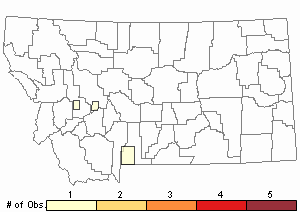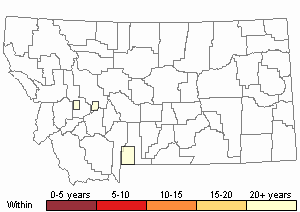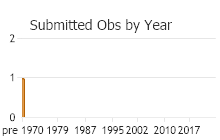View in other NatureServe Network Field Guides
NatureServe
Montana
Utah
Wyoming
Idaho
Wisconsin
British Columbia
South Carolina
Yukon
California
New York
Slow Mountain Grasshopper - Bradynotes obesa
General Description
The following is taken from Capinera et. al. (2004) and Vickery and Kevan (1985). A robust, wingless grasshopper. Brownish dorsally, light ochre below. Some individuals have a light-colored stripe on the top of the abdomen. Hind femur greenish with variable intensities of black chevron markings and orange red on the lower surface. The hind tibia is blackish at the base and red distally—or entirely red. Hebard (1928) states “…one of the most distinctive found in Montana.”
Phenology
Adults have been found from mid-June to mid-September in Montana (Vickery and Kevan 1985).
Diagnostic Characteristics
This is a small species, 18-25 mm long. The prosternal spine is weakly developed. This is a sluggish, slow-moving grasshopper (Capinera et. al. 2004, Vickery and Kevan 1985).
There are two subspecies: B. obesa obesa and B. obesa caurus which occur in Washington state (Vickery and Kevan 1985).
Species Range
Montana Range
Range Descriptions

 Native
Native
Range Comments
Seems to be limited to southwestern Montana, northwestern Wyoming and southeastern Idaho. In Montana, confirmed reports occur for 3 counties (Vickery and Kevan 1985).
Observations in Montana Natural Heritage Program Database
Number of Observations: 3
(Click on the following maps and charts to see full sized version)
Map Help and Descriptions
Relative Density

Recency


 (Observations spanning multiple months or years are excluded from time charts)
(Observations spanning multiple months or years are excluded from time charts)
Habitat
Usually found on mountain slopes at altitude ranges of 4200 to 7800 feet, with rocky slopes and gravelly tops where vegetation is sparse (Vickery and Kevan 1985).
Food Habits
Known to favor various species of Potentilla (Capinera et al. 2004).
Reproductive Characteristics
Virtually unknown. According to literature searches this species remains a poorly studied grasshopper (Vickery and Kevan 1985).
Stewardship Responsibility
References
- Literature Cited AboveLegend:
 View Online Publication
View Online Publication Capinera, J.L., R.D. Scott, and T.J. Walker. 2004. Field Guide to Grasshoppers, Katydids, and Crickets of the United States. Ithaca, NY. Cornell University Press.
Capinera, J.L., R.D. Scott, and T.J. Walker. 2004. Field Guide to Grasshoppers, Katydids, and Crickets of the United States. Ithaca, NY. Cornell University Press. Hebard, M. 1928. The Orthoptera of Montana. Proceedings of the Academy of Natural Sciences of Philadelphia, Vol. 80:211-306.
Hebard, M. 1928. The Orthoptera of Montana. Proceedings of the Academy of Natural Sciences of Philadelphia, Vol. 80:211-306. Vickery, V. R. and D. K. M. Kevan. 1985. The grasshopper, crickets, and related insects of Canada and adjacent regions. Biosystematics Research Institute, Ottawa, Ontario. Publication Number 1777. 918 pp.
Vickery, V. R. and D. K. M. Kevan. 1985. The grasshopper, crickets, and related insects of Canada and adjacent regions. Biosystematics Research Institute, Ottawa, Ontario. Publication Number 1777. 918 pp.
- Additional ReferencesLegend:
 View Online Publication
View Online Publication
Do you know of a citation we're missing? Anderson, N.L. 1962. Grasshopper-vegetation relationships on Montana grasslands. Ph.D Dissertation. Bozeman, Montana: Montana State University. 73 p.
Anderson, N.L. 1962. Grasshopper-vegetation relationships on Montana grasslands. Ph.D Dissertation. Bozeman, Montana: Montana State University. 73 p. Helfer, J.R. 1971. How to Know the Grasshoppers, Crickets, Cockroaches, and Their Allies. Revised edition (out of print), Mineola, NY: Dover Publications.
Helfer, J.R. 1971. How to Know the Grasshoppers, Crickets, Cockroaches, and Their Allies. Revised edition (out of print), Mineola, NY: Dover Publications. Scott, R.D. 2010. Montana Grasshoppers, Katydids, and Crickets A Pictorial Field Guide to the Orthoptera. MagpieMTGraphics, Billings, MT.
Scott, R.D. 2010. Montana Grasshoppers, Katydids, and Crickets A Pictorial Field Guide to the Orthoptera. MagpieMTGraphics, Billings, MT.
- Web Search Engines for Articles on "Slow Mountain Grasshopper"
- Additional Sources of Information Related to "Insects"





